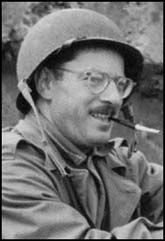
SAN FRANCISCO - Joe Rosenthal, a photojournalist whose Pulitzer Prize-winning image of World War II servicemen raising an American flag over Iwo Jima became the model for the Marine Corps War Memorial, has died. He was 94.
Rosenthal, who took the iconic photograph on Feb. 23, 1945, while working for The Associated Press, died Sunday of natural causes at an assisted living facility in suburban Novato, said his daughter, Anne Rosenthal.
"He was a good and honest man. He had real integrity," she said.
He was also modest. Rosenthal preferred in his role as a combat photographer to chronicle the experiences of soldiers on the front lines, and liked to call himself "a guy who was up in the big leagues for a cup of coffee at one time."
A decade after the flag-raising, he recalled that he did not realize he had shot anything special until days later when the congratulations started pouring in.
"Out of the corner of my eye, I had seen the men start the flag up. I swung my camera and shot the scene," he said a decade afterward. "That is how the picture was taken, and when you take a picture like that, you don't come away saying you got a great shot. You don't know."
The photo quickly became the subject of posters, war-bond drives and a U.S. postage stamp. It kept Rosenthal busy for years as he fielded requests for reprints. He said he was flattered by the attention, but added, "I'd rather just lie down and listen to a ball game."
Located 750 miles south of Tokyo, the small Pacific island of Iwo Jima was important to both Japan and the United States during World War II.
After 30,000 Marines landed there on Feb. 19, 1945, it took four days for a contingent to scale Mount Suribachi, the highest point. More than 6,800 U.S. servicemen died in the five-week battle for the island, and the 21,000-man Japanese defense force was virtually wiped out.
Rosenthal's shutter captured the second raising of the flag on Mount Suribachi after the Marines decided the first flag was too small. Rosenthal later wrote that he almost didn't climb the summit when he learned a flag already had been raised.
"What I see behind the photo is what it took to get up to those heights - the kind of devotion to their country that those young men had, and the sacrifices they made," he said. "I take some gratification in being a little part of what the U.S. stands for."
Besides being awarded the Pulitzer Prize in 1945, the photo made No. 68 on a 1999 New York University survey of the best 100 examples of journalism from the 20th century. Sculptor Felix W. de Weldon used it as the pattern for the Marine Corps memorial, dedicated in 1954 near Arlington National Cemetery in Virginia to commemorate Marines who have died in the line of duty.
Rosenthal nevertheless had to defend the photograph against claims that the second flag raising he shot was staged for his camera. He said that if he had posed it, "I would, of course, have ruined it" by choosing fewer men and making sure their faces could be seen.
His account was later bolstered by a frame captured by a military cameraman, Marine Sgt. Bill Genaust, who filmed the same flag-raising.
The picture later inspired Thomas E. Franklin of The Record of Bergen County, N.J., to photograph three firefighters raising a flag amid the ruins of the World Trade Center on Sept. 11, 2001. Franklin's photo, distributed worldwide by the AP, was a finalist in 2002 for the Pulitzer Prize in breaking news photography.
Rosenthal left the AP later in 1945 to join the San Francisco Chronicle, where he worked as a photographer for 35 years before retiring.
"He was short in stature but that was about it. He had a lot of nerve," said John O'Hara, a retired photographer who worked with Rosenthal at the Chronicle.
O'Hara said Rosenthal took special pride in a certificate naming him an honorary Marine and remained spry and alert well into his 90s.
Chuck de Caro, a former combat reporter for CNN who knew Rosenthal for 30 years, noted his older friend's humility and commitment to his craft. Even after glaucoma affected his eyesight, Rosenthal never hesitated to share war stories and his contacts in both San Francisco and the Marines.
"He had gone through so much history that was sort of obscured by the Iwo Jima photo, and he was very matter-of-fact about it," de Caro said.
Born in Washington, D.C., on Oct. 9, 1911, Rosenthal took up photography as a hobby. During the Depression, he moved to San Francisco, living with a brother until he found a job with the Newspaper Enterprise Association in 1930.
In 1932, Rosenthal joined the old San Francisco News as a combination reporter and photographer.
"They just told me to take this big box and point the end with the glass toward the subject and press the shutter and `We'll tell you what you did wrong,'" he said.
After a short time with ACME Newspictures in San Francisco in 1936, Rosenthal became San Francisco bureau chief of The New York Times-Wide World Photos.
Rosenthal began working for the AP in San Francisco when the news cooperative bought Wide World Photos. After a stint in the Merchant Marine, he returned to the AP and was sent to cover battle areas in 1944.
His first assignment was in New Guinea, and he also covered the invasion of Guam before taking his famous photo on Iwo Jima.
Besides his daughter, Rosenthal is survived by his ex-wife Lee Rosenthal, his son Joseph J. Rosenthal Jr. and their families.
---
Associated Press Writer Greg Risling in Los Angeles contributed to this report.
---
On the Net:

More on Rosenthal: http://www.newseum.org/warstories/interviews/mov/journalists/bio.asp?ID32
More about the photograph
http://www.spartacus.schoolnet.co.uk/USAProsenthal.htm
Photos courtesy AP (one of my former employers)
1 comment:
Nice composition.
Post a Comment